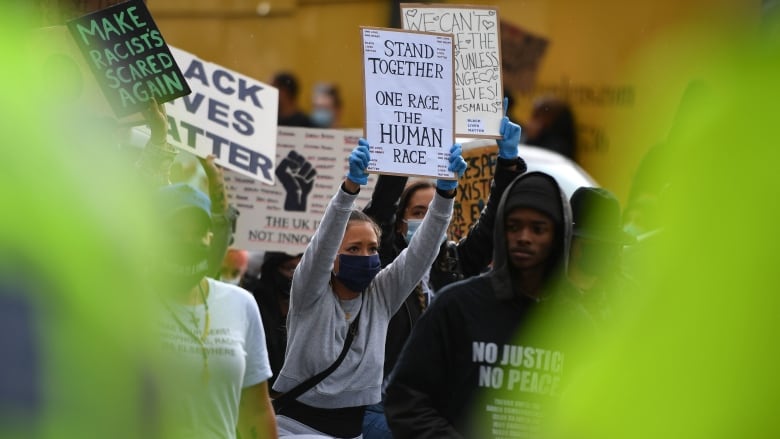How historical racism in science continues to shape the Black experience
While science is meant to be objective, that hasn't been the case on the topic of race

This story is part of theBlack in Sciencespecial airing Feb. 27 onQuirks & Quarks.
Science is meant to be objective. In order to be trusted,it is to be free of any bias or prejudice and simply rely on experimentation, observationand conclusions.
However, that has not been the case when it comes to race.And centuries of scientific racism have been hard to shake even to this day, where the effects are still being seen and felt.
Roberta Timothy, a scientist and researcher at the University of Toronto's Dalla Lana School of Public Health, said that racism can be seen in the response to the current pandemic.
"Black people are disproportionately being impacted by COVID-19," said Timothy, who is researching the Black experience during the pandemic. "They're not being prioritized as a population to be supported, to be cared for, et cetera. And that comes from a history of anti-Black racism and a history of looking at how science is racist."
Racism has been perpetuated under the guise of science going back centuries, notably by 18th-century Swedish botanist Carl Linnaeus, the godfather of taxonomy, and Samuel George Morton, a 19th-century American doctor and anatomy professor who documented the supposed differences between Indigenous people and Europeans by looking at their skulls.
Linnaeus's classification system of human beings reached a pinnacle with the 10th edition of his Systema Naturae, published in 1758, in which he put humans into several categories, including skin colour, behaviour and clothing.
The "Africanus" species, he said, was "lazy, sly, sluggish and neglectful," and the women had "elongated labia" with "breasts lactating profusely."
In 1839, Morton published a book entitled Crania Americana, or A Comparative View of the Skulls of Various Aboriginal Nations of North and South America.The basic summary of his bookis thatCaucasians had the biggest brains, Indigenous peoples were in the middle and "negros" had the smallest, and that this directly corresponded with their respective intellectual capacity.
WATCH |Crania Americanais believed by some to be the most important book in the history of scientific racism:
The University of Pennsylvania Museum of Archaeology and Anthropology which housed a Morton exhibit until July 2020 said in an 1851 obituaryof Morton published by the Charleston Medical Journal of South Carolinathat his research had "given to the negro his true position as an inferior race."
A history of exploitation
These perceived differences have helped drive centuries of oppression. Concepts like these, whichappeared to be rooted in science, were used to rationalize slavery.Painful experimentation was conducted. Segregation was justified.
There are many historical examples. In the 1700s, enslaved men and women were used as guinea pigs to test smallpox vaccines. Between 1845 and 1849,J. Marion Sims, considered the father of gynecology, experimented and operated on Black women with no anesthesia,as it was widely believed that Black people didn't experience pain the same as white people did.
In 1810, Sarah Baartman was taken from her home on South Africa's Eastern Cape and put on display in London "freak show" carnivals, where people could gawk at her semi-naked body.
Why? Because she, as with many of her Khoikhoi people, had large buttocks not seen before. (This trait, in which thereis a high amount of tissue in the buttocks and thighs, is called steatopygia.) Referred to as the "Hottentot Venus," Baartman died in 1815, at the age of 26, in France.

When she died, there was no autopsy. Instead, she was dissected. Her skeleton and a cast of her body was put on display in a museum in Angers, France. After years of fighting to have her remains repatriated including efforts by Nelson Mandela Baartmanwas returned to South Africa in 2002.
Believing that Black people were less than human resulted in other tragic episodes that aren't relegated to the distant past.
One of the most notable wasthe Tuskegee syphilis study, which began in 1932, where almost 400 Black men were left untreated for their disease in a government experiment that went on for 40 years. By the time it was exposed in a 1972 New York Times story, 128 men had died of the disease orcomplications from it, 40 of their wives had been infected and 19 children had also been infected.
A continuingbattle
These are just a handful of examples of how science failed Black people throughout the centuries. But it hasn't ended.
Studies have shown that Black people continue to receive poorer health care. The idea about pain? It persists today.
Almost a year into the COVID-19 pandemic, there has been increased awareness of the disparities between the care delivered to white people versus people of colour, and in particular Black and Indigenous people.
According to the Centers for Disease Control and Prevention (CDC), people in the Black community are almost three times more likely to die of COVID-19 than those who identify as being white.
It's not solely an American issue. The City of Toronto reports that Black people make up roughly nine per cent of the populationbut account for 16 per cent of COVID-19 cases, compared with white people, who make up48 per cent of the population but account for 21 per cent of cases.
The pandemic hasalso helped shed some light on why these communities may be skeptical of vaccines and medicine in general.

"We think about that forced smallpox situation with enslaved Africans, and now what's happening with vaccines, there's a connection," said Timothy. "People keep on talking about vaccine hesitation. It's vaccine mistrust. It's a very different thing."
Race 'a social construct'
Ultimately.race isn't something that is based on scientific evidence.
"[Race] is a social construct. In fact, it's been since the 1950s that UNESCO brought together politicians, anthropologists, policymakers, scientists, and affirmed in a series of statements that race is a social construct," said Angel Saini, a science journalist and author of the book Superior: The Return of Race Science.
"So we've known it for a long time. And in fact, data over those decades has only confirmed that we know it now even more than we knew it before:We are one human species."
The persistence of the idea of race and differences is a difficult one to shake, according to Saini, particularly since it helps support the status quo.
"The white supremacist worldview, for instance, is very self-serving," she said."Because it essentially says, 'We are better than you. And that is why wehave more money and more opportunities, while we are so well representedacross all industries and the establishment, because we are just deep down better than you.'"
Butshe saidthere's noscientific evidence to supportthis.
"This idea that there are any kind of natural dividing lines, or that there are Black genes or white genes, just isn't true. There is no gene that exists in all the members of one so-called race and not in any other."
For more stories about the experiences of Black Canadians from anti-Black racism to success stories within the Black community check out Being Black in Canada, a CBC project Black Canadians can be proud of. You can read more stories here.














_(720p).jpg)


 OFFICIAL HD MUSIC VIDEO.jpg)
.jpg)



























































































